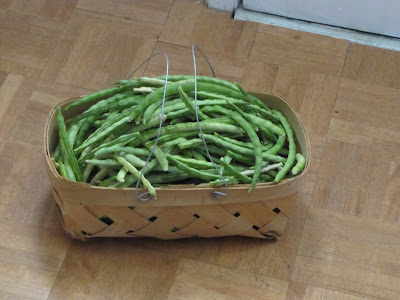Peas.
They have been a staple of my diet all my life.
My siblings and I even sung about them: Peas, peas, peas, eating goober peas. Thankfully, I don't remember the rest of the song.
From July to early October, in good years, they were on the table at dinner and supper. Beautiful peas. After the season had passed, we would have them canned or dried.
Oh, NOW I remember why we didn't get bored during the summer. We shelled peas for canning! My parents planted rows and rows of peas, their purple hulls calling to us. We picked them in half-bushel baskets and five-gallon buckets. Because our family liked the purple hull variety, our thumbs and fingertips would retain their purplish color for weeks.
After Mama had canned all she needed, the rest of the peas were allowed to dry on the vine. When they were completely dry, we would pick them and store them in tow sacks (burlap bags). On some cool October Saturday, when the sky was so blue you cried and a brisk breeze was blowing, we had fun beating the pea-filled tow sacks with bats until they were flattened. We then removed the dry hulls from the bags. The peas left in the bottom would be poured from one pan to another, until the wind had blown away all the tiny bits of hull and the peas were clean. Mama had gallon jugs with tight fitting lids that the peas were kept in for storage. Mama cooked these dried peas in pots with bacon and dried cayenne pepper pods.
A dear friend in her nineties shared with me about living in the Great Depression in the 1930s. There were no jobs, and families grew what they ate. She told me about one particular winter when all the food ran out except the dried peas. Her mother did all she could do--she cooked the dried peas and served them for breakfast, dinner, and supper. Out of all the struggles they went through, my friend remembers the peas.
The grass in the sunny spot in my backyard long ago was tilled up for planting vegetables. Since it is so small, we have to choose carefully what to plant. There are always peppers and tomatoes, but we try to rotate the other vegetables. This year, we have peas. We were blessed with abundant rain in June, and now the plants are beautiful and producing all the peas we can eat.
Here's how I cook them.
Pick the peas.
Shell the peas. Are all of you still with me?
Put in a pot large enough to give the peas plenty of room to expand. Cover them with enough water to have about two inches at the top.
Bring to a boil, then reduce heat to simmer.
Add chopped bacon, or some bacon drippings if you are blessed, some oil if you are not. Add salt to taste.
Simmer until you can't wait any longer.
Cook up something to go with the peas. . .
Take a hunk of cornbread, split it on a plate. Cover with peas, adding enough pot likker to make the cornbread mushy.
Add whatever else you need, which probably won't be much.
Enjoy!








I remember the lyrics and I found this. http://en.wikipedia.org/wiki/Goober_Peas
ReplyDelete